1998 HONDA ODYSSEY window
[x] Cancel search: windowPage 146 of 272

Parking
Always use the parking brake when
you park your vehicle. The indicator on the instrument panel shows that
the parking brake is not fully
released; it does not indicate that the
parking brake is firmly set. Make sure the parking brake is set firmly
or your vehicle may roll if it is
parked on an incline.
Set the parking brake before you put
the transmission in Park. This keeps
the vehicle from moving and putting
pressure on the parking mechanism
in the transmission — making it
easier to move the shift lever out of
Park when you want to drive away. If the vehicle is facing uphill, turn
the front wheels away from the curb.
If the vehicle is facing downhill, turn
the front wheels toward the curb.
Make sure the parking brake is fully
released before driving away.
Driving with the parking brake
partially set can overheat or damage
the rear brakes. Parking Tips Make sure the sunroof and the
windows are closed. Turn off the lights.
Place any packages, valuables, etc.,
in the cargo area or take them
with you. Lock the doors with the key or the
remote transmitter.
Never park over dry leaves, tall
grass, or other flammable
materials. The three way catalytic
converter gets very hot, and could
cause these materials to catch on
fire.
DrivingProCarManuals.comMain Menu Table of Contents s t
Page 151 of 272
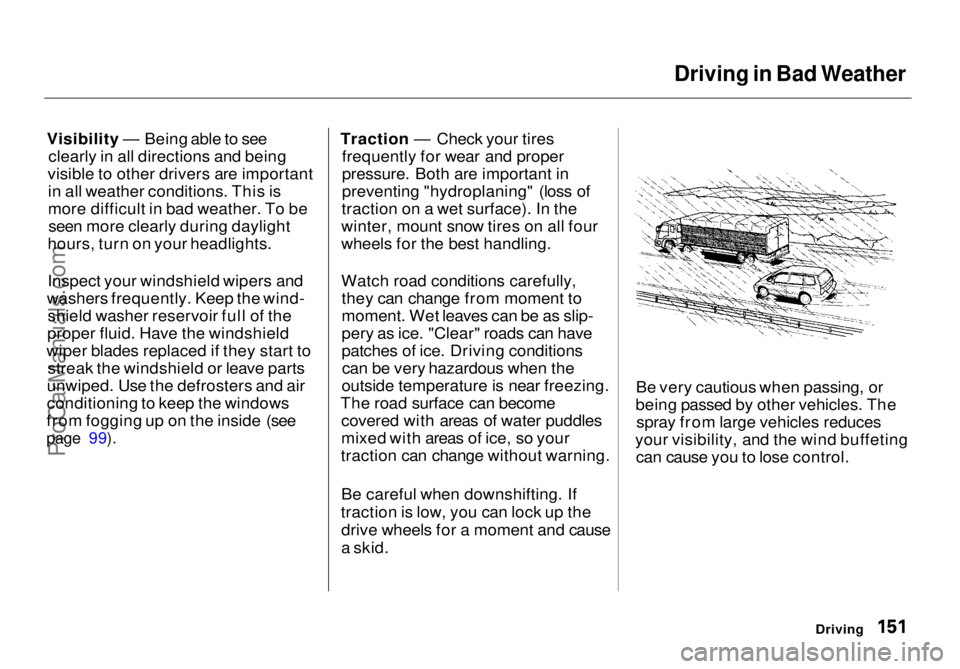
Driving in Bad Weather
Visibility — Being able to see clearly in all directions and being
visible to other drivers are important in all weather conditions. This is
more difficult in bad weather. To beseen more clearly during daylight
hours, turn on your headlights.
Inspect your windshield wipers and
washers frequently. Keep the wind- shield washer reservoir full of the
proper fluid. Have the windshield
wiper blades replaced if they start to streak the windshield or leave parts
unwiped. Use the defrosters and air
conditioning to keep the windows
from fogging up on the inside (see
page 99).
Traction — Check your tires
frequently for wear and proper
pressure. Both are important in
preventing "hydroplaning" (loss of
traction on a wet surface). In the
winter, mount snow tires on all four
wheels for the best handling.
Watch road conditions carefully, they can change from moment to
moment. Wet leaves can be as slip-
pery as ice. "Clear" roads can have
patches of ice. Driving conditionscan be very hazardous when the
outside temperature is near freezing.
The road surface can become covered with areas of water puddles
mixed with areas of ice, so your
traction can change without warning.
Be careful when downshifting. If
traction is low, you can lock up the drive wheels for a moment and cause
a skid. Be very cautious when passing, or
being passed by other vehicles. The spray from large vehicles reduces
your visibility, and the wind buffeting can cause you to lose control.
DrivingProCarManuals.comMain Menu Table of Contents s t
Page 188 of 272
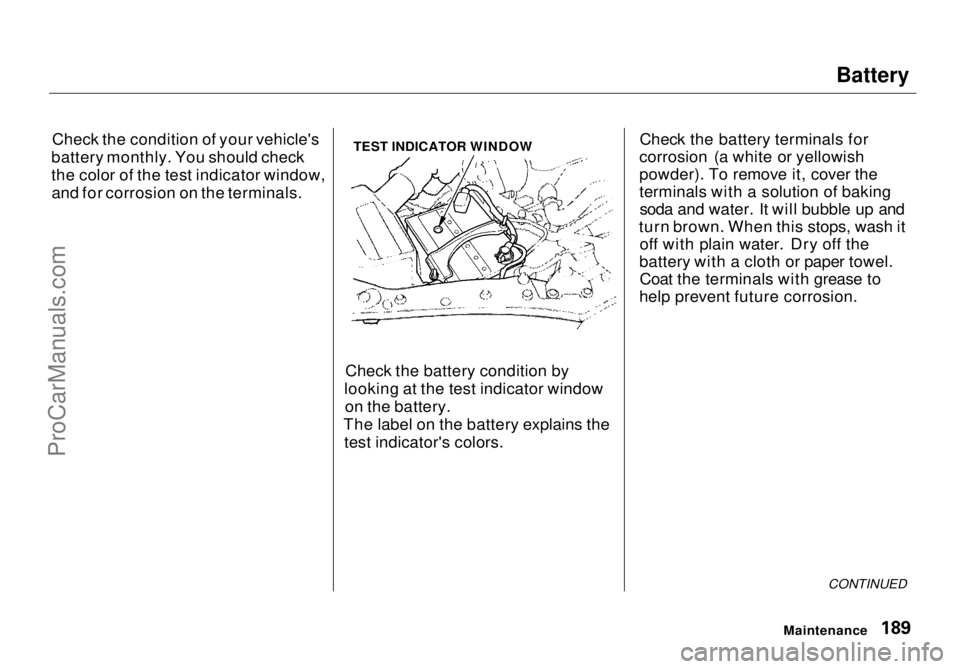
Battery
Check the condition of your vehicle's
battery monthly. You should check
the color of the test indicator window, and for corrosion on the terminals. TEST INDICATOR WINDOW
Check the battery condition by
looking at the test indicator window on the battery.
The label on the battery explains the test indicator's colors. Check the battery terminals for
corrosion (a white or yellowish
powder). To remove it, cover the
terminals with a solution of baking soda and water. It will bubble up and
turn brown. When this stops, wash it off with plain water. Dry off the
battery with a cloth or paper towel. Coat the terminals with grease to
help prevent future corrosion.
CONTINUED
MaintenanceProCarManuals.comMain Menu Table of Contents s t
Page 210 of 272
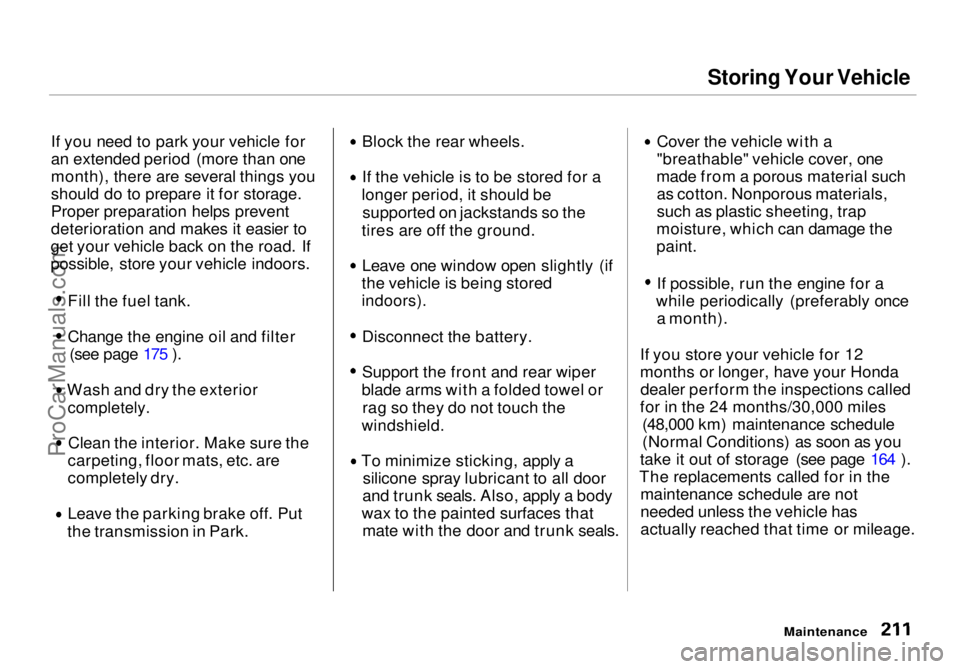
Storing Your Vehicle
If you need to park your vehicle for
an extended period (more than one
month), there are several things you
should do to prepare it for storage.
Proper preparation helps prevent
deterioration and makes it easier to
get your vehicle back on the road. If
possible, store your vehicle indoors.
Fill the fuel tank.
Change the engine oil and filter(see page 175 ). Wash and dry the exterior
completely.
Clean the interior. Make sure the
carpeting, floor mats, etc. are
completely dry. Leave the parking brake off. Put
the transmission in Park. Block the rear wheels. If the vehicle is to be stored for a
longer period, it should be supported on jackstands so the
tires are off the ground.
Leave one window open slightly (if
the vehicle is being stored
indoors).
Disconnect the battery.
Support the front and rear wiper
blade arms with a folded towel or rag so they do not touch the
windshield.
To minimize sticking, apply a
silicone spray lubricant to all door
and trunk seals. Also, apply a body
wax to the painted surfaces that mate with the door and trunk seals. Cover the vehicle with a
"breathable" vehicle cover, one
made from a porous material such as cotton. Nonporous materials,
such as plastic sheeting, trap
moisture, which can damage the
paint. If possible, run the engine for a
while periodically (preferably once a month).
If you store your vehicle for 12
months or longer, have your Honda dealer perform the inspections called
for in the 24 months/30,000 miles (48,000 km) maintenance schedule
(Normal Conditions) as soon as you
take it out of storage (see page 164 ).
The replacements called for in the maintenance schedule are not
needed unless the vehicle has
actually reached that time or mileage.
MaintenanceProCarManuals.comMain Menu Table of Contents s t
Page 211 of 272

Appearance Care
Regular cleaning and polishing of
your Honda helps to keep it "new" looking. This section gives you hintson how to clean your vehicle and
preserve its appearance: the paint,
brightwork, wheels and interior. Also included are several things you can
do to help prevent corrosion. Exterior Care.................................. 214
Washing...................................... 214
Waxing........................................ 215
Aluminum Wheels..................... 215
Paint Touch-up........................... 215
Interior Care................................... 216 Carpeting.................................... 216
Fabric.......................................... 216
Vinyl............................................ 216
Seat Belts.................................... 217
Windows..................................... 217
Air Fresheners........................... 217
Corrosion Protection..................... 218
Body Repairs.................................. 219
Appearance CareProCarManuals.comMain Menu s t
Page 215 of 272
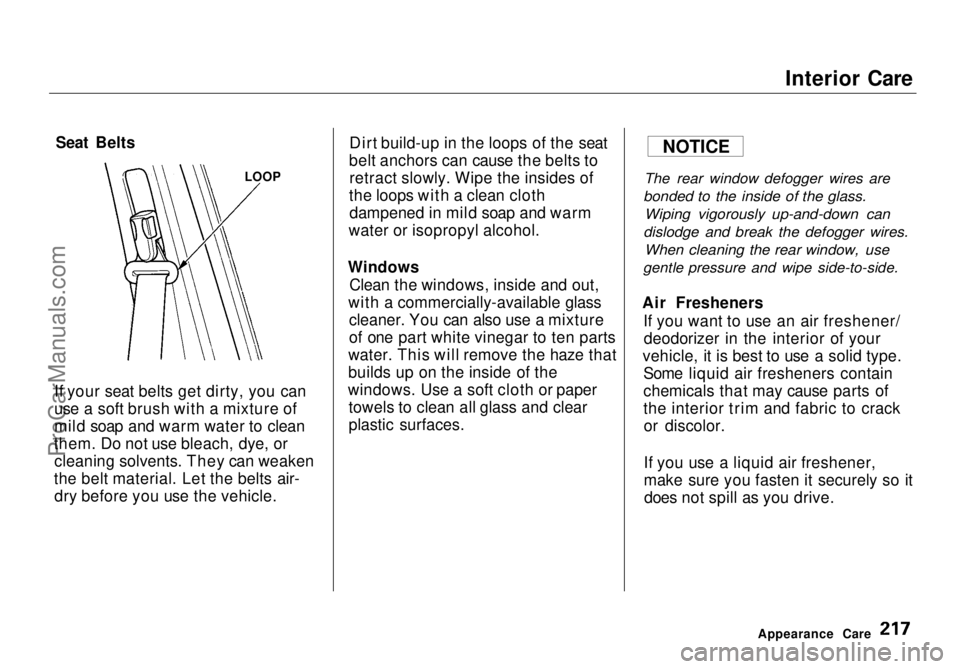
Interior Care
Seat Belts
If your seat belts get dirty, you can
use a soft brush with a mixture of
mild soap and warm water to clean
them. Do not use bleach, dye, or cleaning solvents. They can weaken
the belt material. Let the belts air- dry before you use the vehicle. Dirt build-up in the loops of the seat
belt anchors can cause the belts to retract slowly. Wipe the insides of
the loops with a clean cloth dampened in mild soap and warm
water or isopropyl alcohol.
Windows Clean the windows, inside and out,
with a commercially-available glass cleaner. You can also use a mixture
of one part white vinegar to ten parts
water. This will remove the haze that
builds up on the inside of the
windows. Use a soft cloth or paper towels to clean all glass and clear
plastic surfaces.
The rear window defogger wires are
bonded to the inside of the glass.
Wiping vigorously up-and-down can
dislodge and break the defogger wires.
When cleaning the rear window, use
gentle pressure and wipe side-to-side.
Air Fresheners If you want to use an air freshener/deodorizer in the interior of your
vehicle, it is best to use a solid type. Some liquid air fresheners contain
chemicals that may cause parts of
the interior trim and fabric to crackor discolor.
If you use a liquid air freshener,
make sure you fasten it securely so itdoes not spill as you drive.
Appearance Care
LOOP
NOTICEProCarManuals.comMain Menu Table of Contents s t
Page 232 of 272
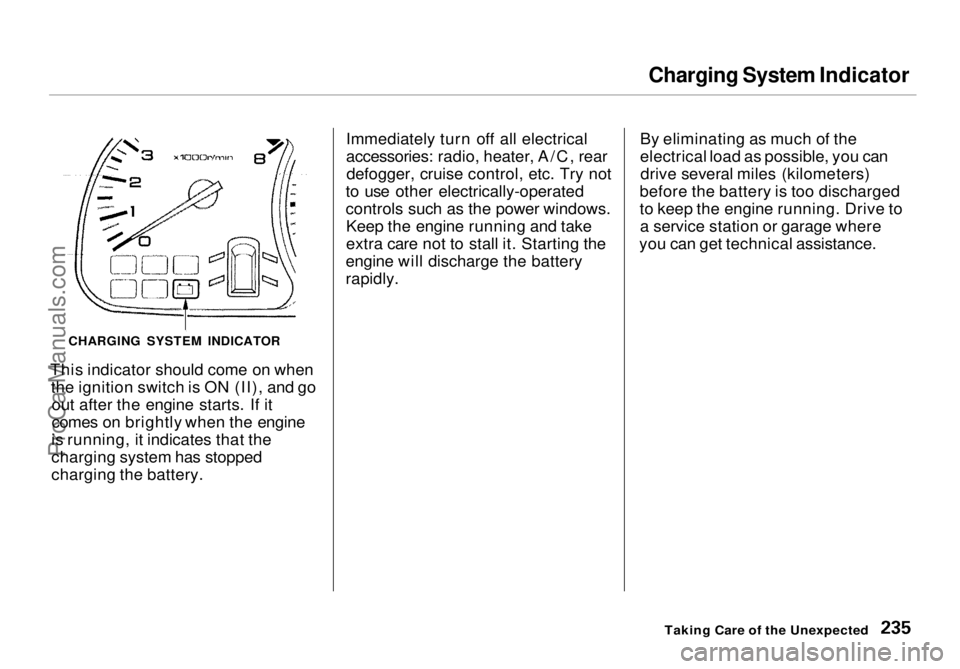
Charging System Indicator
This indicator should come on when the ignition switch is ON (II), and goout after the engine starts. If it
comes on brightly when the engine
is running, it indicates that the
charging system has stopped
charging the battery. Immediately turn off all electrical
accessories: radio, heater, A/C, rear
defogger, cruise control, etc. Try not
to use other electrically-operated
controls such as the power windows. Keep the engine running and take
extra care not to stall it. Starting the
engine will discharge the battery
rapidly. By eliminating as much of the
electrical load as possible, you can
drive several miles (kilometers)
before the battery is too discharged
to keep the engine running. Drive to a service station or garage where
you can get technical assistance.
Taking Care of the Unexpected
CHARGING SYSTEM INDICATORProCarManuals.comMain Menu Table of Contents s t
Page 264 of 272

Index
Brakes Anti-lock System (ABS)............ 148
Break-in, New Linings .............. 128
Fluid............................................ 183
Light, Burned-out...................... 196
Parking.......................................... 85
System Indicator.......................... 52
Wear Indicators......................... 147
Brakes, ABS Operation.................................... 148
System Indicator.................. 53, 149
Braking System.............................. 147
Break-in, New Car......................... 128
Brightness Control, Instruments... 59
Brights, Headlights......................... 58
Bulb Replacement Back-up Lights........................... 208
Brake Lights............................... 208
Ceiling Light............................... 210
Front Parking Lights................. 207
Front Side Marker Lights......... 207
Headlights.................................. 206
License Plate Lights.................. 209
Specifications............................. 249
Turn Signal Lights..................... 207
Bulbs, Halogen............................... 206 Cables, Jump Starting With.......... 231
Capacities Chart............................. 248
Carbon Monoxide Hazard.............. 47
Carrying Cargo.............................. 137
Cassette Player Care............................................. 121
Operation............................ 107, 119
CAUTION, Explanation of............... ii
CD Player ............................... 110, 122
Center Pocket.................................. 88
Certification Label......................... 246
Chains............................................. 201
Change Oil
How to......................................... 175
When to....................................... 164
Changing a Flat Tire..................... 223
Changing Engine Coolant............. 179
Charging System Indicator.... 52, 235
Checking Automatic Transmission
Fluid........................................ 182
Battery Condition...................... 189
Brake Fluid................................. 183
Drive Belts.................................. 195
Engine Coolant........................... 132
Engine Oil................................... 131
Fuses........................................... 240
Power Steering Fluid................. 184
Checklist, Before Driving............. 140
Childproof Door Locks................... 72
Cigarette Lighter............................. 89
Cleaner, Air.................................... 185
Cleaning
Aluminum Wheels..................... 215
Carpeting.................................... 216
Exterior....................................... 214
Fabric.......................................... 216
Interior........................................ 216
Seat Belts.................................... 217
Vinyl............................................ 216
Window....................................... 217
CLEAN Light................................. 121
Clock, Setting the ............................ 86
CO in the Exhaust......................... 255
Cold Weather, Starting in............. 141
Compact Spare............................... 222
Consumer Information*................ 260
Controls, Instruments and.............. 49ProCarManuals.comMain Menu s t